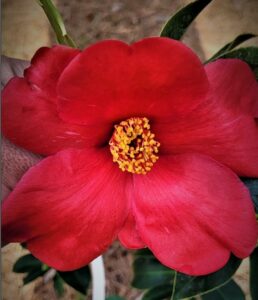New Variety of Camellia in the Arboretum Collection
go.ncsu.edu/readext?904904
en Español / em Português
El inglés es el idioma de control de esta página. En la medida en que haya algún conflicto entre la traducción al inglés y la traducción, el inglés prevalece.
Al hacer clic en el enlace de traducción se activa un servicio de traducción gratuito para convertir la página al español. Al igual que con cualquier traducción por Internet, la conversión no es sensible al contexto y puede que no traduzca el texto en su significado original. NC State Extension no garantiza la exactitud del texto traducido. Por favor, tenga en cuenta que algunas aplicaciones y/o servicios pueden no funcionar como se espera cuando se traducen.
Português
Inglês é o idioma de controle desta página. Na medida que haja algum conflito entre o texto original em Inglês e a tradução, o Inglês prevalece.
Ao clicar no link de tradução, um serviço gratuito de tradução será ativado para converter a página para o Português. Como em qualquer tradução pela internet, a conversão não é sensivel ao contexto e pode não ocorrer a tradução para o significado orginal. O serviço de Extensão da Carolina do Norte (NC State Extension) não garante a exatidão do texto traduzido. Por favor, observe que algumas funções ou serviços podem não funcionar como esperado após a tradução.
English
English is the controlling language of this page. To the extent there is any conflict between the English text and the translation, English controls.
Clicking on the translation link activates a free translation service to convert the page to Spanish. As with any Internet translation, the conversion is not context-sensitive and may not translate the text to its original meaning. NC State Extension does not guarantee the accuracy of the translated text. Please note that some applications and/or services may not function as expected when translated.
Collapse ▲
Article contributed by Kevin Cassel, Arboretum Grounds Supervisor
Camellias are well-known as a garden staple throughout the southern United States. When everything else is dormant, they offer vibrant, lush, and beautiful blooms through those cold winter months. Camellias are largely placed in two camps; the fall bloomers or Camellia sasanqua, which typically bloom from October through December; and the winter bloomers or Camellia japonica, which typically bloom from December through April. Camellia plant breeders, hybridizers, and enthusiasts are continually looking to create varieties that push the limits of what camellias are capable of traditionally. They are usually hardy in zones 7-10 but some hybrids have been developed that do well into zone 6. Getting the plants of each camp to bloom outside of their traditional periods is a sought-after achievement.
Making its way into the camellia connoisseur’s gardens, there is a hybrid variety that pushes the limit of bloom season, especially for a plant containing C. japonica parentage. First flowering in 2007 and developed by E. Hulyn Smith of Valdosta, Georgia and registered in 2009, Camellia hybrid ‘Wendzalea’, has made it’s way into our collection. It is a cross between Camellia azalea and Camellia japonica ‘Wendy’. A single, ruby red, flower surrounds upright golden anthers and salmon pink filaments. We are grateful for the donated plants by Mark Crawford of Loch Laurel Nursery in February 2022. After planting, we had a fully open bloom on September 27th, which was a sight to see (pictured below). ‘Wendzalea’ is also touted as having a second flush of flowers in late January to February! This will be one to watch – we can’t wait!




